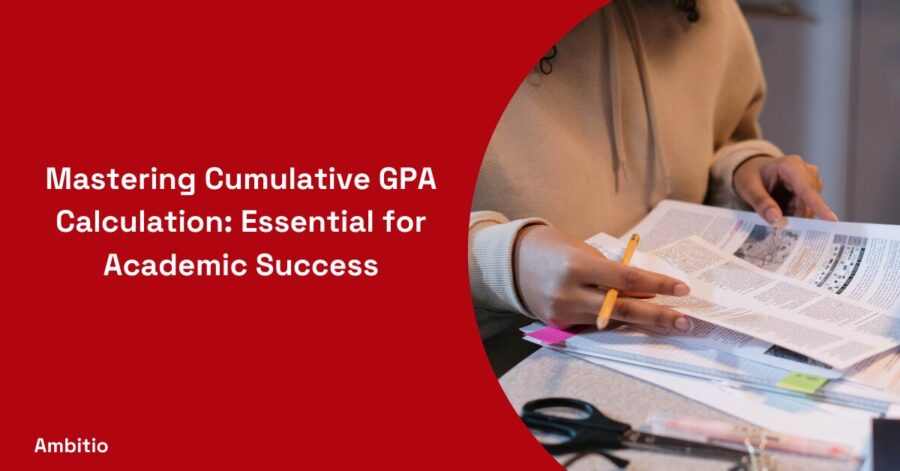12 December 2024
6 minutes read
Mastering Cumulative GPA Calculation: Essential for Academic Success

Introduction
Understanding and accurately calculating your cumulative GPA (Grade Point Average) is more than just a mathematical exercise; it’s a critical skill for students navigating the academic landscape of high school and college.
This comprehensive guide is designed to demystify the process of GPA calculation, offering insights into its significance for college admissions and academic planning.
Whether you’re a high school freshman or a college senior, mastering your cumulative GPA calculation is a stepping stone to academic success.
Understanding Cumulative GPA
The Concept of Cumulative GPA
Definition and Importance
Cumulative GPA, or the average of all your grades over your academic career, serves as a cornerstone in understanding your academic progress. It’s a numeric representation of your overall academic performance, encapsulating every class, every semester.
Colleges and employers often look at your cumulative GPA as a measure of your consistency and dedication to your studies. A solid understanding of what cumulative GPA entails is essential for every student.
Cumulative vs. Semester GPA
| Feature | Cumulative GPA | Semester GPA |
|---|---|---|
| Definition | The average of all grades earned over an entire academic career. | The average of grades earned in a single academic term (semester). |
| Scope | Encompasses all completed courses from the start of your academic journey. | Limited to courses taken in a specific semester. |
| Purpose | Reflects overall academic performance and consistency. Used for graduation requirements, overall academic assessment, and post-graduate opportunities. | Indicates performance in a particular term. Useful for tracking progress and identifying areas needing improvement. |
| Calculation Frequency | Updated less frequently, usually at the end of each academic year. | Calculated at the end of each semester. |
| Impact on Academic Profile | A comprehensive indicator of a student’s overall academic strengths and weaknesses. More significant in long-term academic evaluations like college admissions or job applications. | Offers a snapshot of a student’s recent academic performance. Influential in short-term academic decisions and adjustments. |
| Fluctuation | Tends to fluctuate less due to the accumulation of grades over time. | More susceptible to significant changes based on the performance in a single semester. |
| Improvement Strategy | Requires a longer-term strategy; improvements are gradual as they reflect an average over time. | Visible improvements can be achieved more quickly, reflecting changes in study habits or course selection. |
| Emphasis in Admissions | Heavily weighted in college and university admissions, scholarships, and certain employment opportunities. | May be considered for program qualifications, scholarships, and academic warnings, but less emphasized than cumulative GPA. |
| Flexibility | Less flexible, as changes require consistent performance over multiple semesters. | More flexible, allowing for adjustments and improvements in a shorter timeframe. |
| Representation of Trends | Shows long-term academic trends and consistency. | Highlights immediate academic trends, useful for quick feedback and adjustments. |
The Role of Cumulative GPA in Academic Planning
Setting Academic Goals
Your cumulative GPA isn’t just a number; it’s a tool for academic planning. By understanding where you stand, you can set realistic goals for improvement or maintenance.
Whether it’s aiming for the honor roll, qualifying for scholarships, or simply staying above a certain threshold, your cumulative GPA can guide your academic decisions and efforts.
Identifying Areas for Improvement
Regularly calculating your cumulative GPA allows you to identify subjects or semesters where you may have struggled. This insight is invaluable for making targeted efforts to improve in those areas, whether through tutoring, additional study time, or course selection strategies in future semesters.
Demystifying the GPA Calculation Process
Step-by-Step Breakdown of Calculating GPA
Calculating your GPA (Grade Point Average) is a straightforward process when broken down into manageable steps. Here’s how you can calculate it:
Step 1: Understand the Grading Scale
Most schools use a 4.0 grading scale where each letter grade corresponds to a numerical value (e.g., A = 4.0, B = 3.0, etc.). Familiarize yourself with the grading scale used by your institution.
Step 2: Convert Letter Grades to Numerical Values
For each course, convert your letter grade into its numerical equivalent based on the grading scale. For example, an A might be a 4.0, a B a 3.0, and so forth.
Step 3: Multiply by Credit Hours
Each course is usually worth a certain number of credit hours. Multiply the numerical grade for each course by its corresponding credit hours. This gives you the grade points for each course. For instance, if you received a 3.0 (B) in a 4-credit hour course, you would calculate 3.0 x 4 = 12 grade points for that course.
Step 4: Add Up Total Grade Points
Add together the grade points for all courses. This total will be used to calculate your GPA.
Step 5: Sum Total Credit Hours
Also, add up the total number of credit hours for all the courses you have taken. This is the denominator in your GPA calculation.
Step 6: Divide Total Grade Points by Total Credit Hours
To find your GPA, divide the total grade points by the total number of credit hours. For example, if your total grade points are 48 and your total credit hours are 16, your GPA would be 48 ÷ 16 = 3.0.
Step 7: Round to the Appropriate Decimal Place
Round your result to the decimal place that your school uses, typically to two decimal places.
Step 8: Understanding Weighted vs. Unweighted GPA
If calculating a weighted GPA (which accounts for the difficulty of the courses), use the modified scale provided by your school. Advanced or honors courses might be on a 5.0 scale, for example.
Step 9: Repeat Each Semester
Repeat this process for each semester to calculate your semester GPA.
Step 10: Calculate Cumulative GPA
For your cumulative GPA, perform this calculation using all courses you’ve taken over your academic career.
Common Mistakes to Avoid in GPA Calculation
When calculating your GPA, it’s essential to avoid these common mistakes to ensure accuracy:
- Misinterpreting the Grading Scale: Not using the correct numerical values for letter grades according to your institution’s specific scale.
- Incorrectly Weighting Courses: Failing to differentiate between weighted (like honors or AP courses) and unweighted courses, which can affect the overall GPA calculation.
- Miscalculating Credit Hours: Overlooking or incorrectly assigning the number of credit hours for each course. Remember that the grade point for each course is the product of its credit hours and the numerical grade.
- Rounding Grades Prematurely: Rounding off grades or GPA at each calculation step instead of at the end, which can lead to inaccuracies.
- Excluding Failed Courses: Not including failed courses in the calculation. Most institutions require that these courses be factored into the overall GPA.
- Neglecting Repeated Courses: If a course is repeated, ensure you follow your institution’s policy on how to incorporate these grades into your GPA.
- Forgetting to Update Calculations: Not recalculating your cumulative GPA each semester to include your most recent grades.
- Overlooking Academic Forgiveness Policies: Some institutions have policies that exclude certain courses from GPA calculations under specific conditions. Not being aware of these can lead to errors.
- Confusing Semester GPA with Cumulative GPA: Mixing up the calculations for semester and cumulative GPAs. Remember, cumulative GPA is an average of all semesters.
- Not Double-Checking Calculations: Simple mathematical errors or data entry mistakes can significantly alter your GPA. Always double-check your calculations.
By avoiding these common pitfalls, you can ensure a more accurate and reflective GPA calculation.
Navigating GPA Calculators and Tech Tools
Choosing the Right GPA Calculator
With a plethora of online GPA calculators available, choosing the right one can be overwhelming. This section will review what to look for in a reliable GPA calculator, including accuracy, ease of use, and compatibility with your school’s grading system.
Leveraging Technology for GPA Tracking
Beyond calculators, various apps and software can help you track and predict your GPA over time. We’ll explore how these tools can assist in academic planning, goal setting, and even stress reduction by providing a clear picture of your academic trajectory.
GPA in the Context of College Admissions
How Colleges View Cumulative GPA
Understanding how colleges interpret your cumulative GPA is crucial for any college-bound student. This section will delve into the role of GPA in admissions decisions, how it’s weighed against other factors, and what GPA ranges different types of colleges typically expect.
Improving Your GPA for College Admissions
If your GPA isn’t where you want it to be for college admissions, all is not lost. We’ll offer strategies for improving your cumulative GPA, discussing how much impact late high school grades can have and how to effectively communicate your academic growth to colleges.
Beyond Grades: The Holistic Importance of GPA
GPA as a Reflection of Learning Habits
Your cumulative GPA is more than a metric; it’s a reflection of your learning habits and skills. This section will explore how maintaining a good GPA develops discipline, time management, and study skills that are invaluable in both academic and professional settings.
Balancing GPA with Overall Wellbeing
While striving for a high GPA is commendable, it’s essential to balance academic pursuits with overall well-being. We’ll discuss the importance of not letting GPA obsession overshadow mental health, extracurricular activities, and personal growth.
Conclusion
Mastering the calculation and understanding of your cumulative GPA is an indispensable part of your academic journey. Whether you’re aiming for college admissions or planning your high school courses, a clear grasp of your GPA can significantly impact your academic decisions and success.
Remember, your GPA is a significant part of your academic story, but it’s not the only part. Strive for balance, seek improvement, and use your GPA as a tool to guide your educational path.
FAQs
Q1: How often should I calculate my cumulative GPA?
Ideally, you should calculate it at the end of each academic term to track your progress.
Q2: Can I improve my cumulative GPA?
Yes, by earning higher grades in subsequent courses, you can gradually improve your cumulative GPA.
Q3: Does a low GPA ruin my chances for college admissions?
While a low GPA can be a disadvantage, colleges also consider other factors like extracurricular activities, essays, and recommendations.
Q4: Is it necessary to include my cumulative GPA in my resume?
It’s recommended if your GPA is high, as it can be a testament to your academic achievements.

You can study at top universities worldwide!
Get expert tips and tricks to get into top universities with a free expert session.
Book Your Free 30-Minute Session Now! Book a call now




























